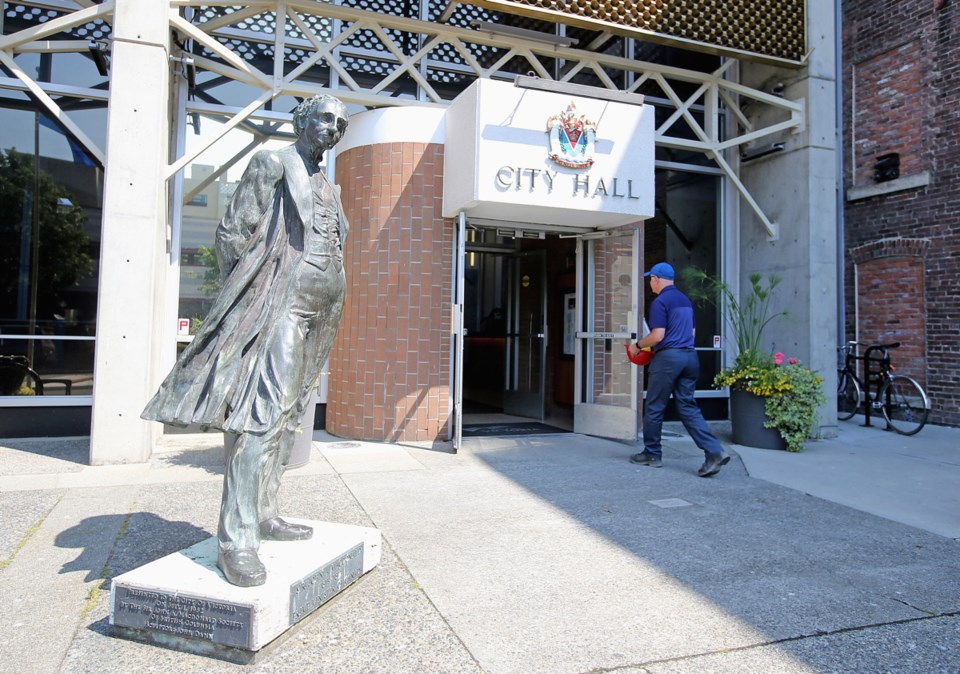Victoria councillors have voted to remove the statue of Sir John A. Macdonald from city hall, but the debate is far from over.
Councillors meeting as committee of the whole Thursday morning voted 7-1 to remove the statue of Canada’s first prime minister, which was installed in 1982. Coun. Geoff Young was the lone dissenting vote and Coun. Ben Isitt was absent. The decision was ratified by council Thursday night.
Some councillors raised concerns about a lack of public consultation and questioned why the mayor informed them only on Tuesday about removing the statue.
Mayor Lisa Helps said a group made up of councillors and First Nations representatives recommended removing the statue, after months of discussion.
Macdonald was member of Parliament for Victoria from 1878 to 1882 and prime minister when the residential schools system was created.
Helps said if the city is sincere about reconciliation efforts, the statue must be removed, put in storage and its future location discussed, so that Indigenous people are not forced to encounter a painful reminder of colonial violence each time they enter city hall.
“It is about rewriting history, but it is not about erasing history,” Helps said.
Young expressed regret about the negative impact the statue has on Indigenous people, but said the public deserved to be included in the discussion.
Coun. Pam Madoff questioned how the mayor could talk about “careful, conscious collaboration” and then surprise councillors with the agenda item on Tuesday, leaving them little time to respond to residents’ concerns or make concrete plans for the statue’s relocation. “The concern I have is the timing of this and the way the public has been made aware of it, which has made it unnecessarily contentious,” Madoff said. “Reconciliation is about the broader community, about all of us.”
Plans call for a plaque to be put in the statue’s place, with the inscription: “In 2017, the City of Victoria began a journey of Truth and Reconciliation with the Lekwungen peoples, the Songhees and Esquimalt Nations, on whose territories the city stands.”
Both the Songhees and Esquimalt Nations support the statue’s removal.
In a letter to council, Songhees Nation Chief Ron Sam called the removal “a visible symbol of progress, of rejecting oppression and embracing a new and inclusive way to work.”
Katie Hooper, executive director of the Esquimalt Nation, said removing the statue is a symbol of progress toward an end to discrimination and oppression. It is an important step in the city’s reconciliation journey “that will lead to a greater path of understanding for the future.”
Macdonald’s statue was paid for and donated by the Sir John A. Macdonald Society of B.C., a citizens’ group.
University of Victoria history professor John Lutz said the statue can serve as an opportunity for education and conversation around the multiple stories concerning Macdonald. “I hope they relocate it to a place that is still prominent so we can still manage to use it as a way to discuss reconciliation.”
Macdonald had a role in establishing the Indian Act and residential schools, but he also had role in founding “one of the greatest democracies in the world,” Lutz said. “Both those stories are worth telling.”
Macdonald’s racist views should not be downplayed, Lutz said, but the residential school system emulated a movement in the United States and other places that Macdonald supported as a reflection of the “common wisdom of progressive people of his time” to provide education for First Nations and bring them into western culture. “Obviously, today we know that was a misguided view.”
“The residential schools he envisioned were not the residential schools that ultimately 30 or 40 years later became quite abusive [and oppressive] institutions,” he said. “And in the 20th century, they became compulsory. They were not compulsory in Macdonald’s time.”



